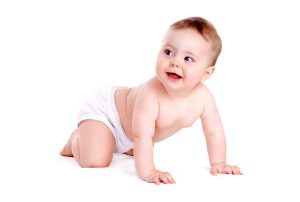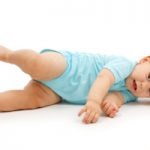
 Your baby is on the move! Welcome to the days of following him from room to room as he explores his world. This can be exhausting for you, but it’s one of the most complex and valuable stages of his development.
Your baby is on the move! Welcome to the days of following him from room to room as he explores his world. This can be exhausting for you, but it’s one of the most complex and valuable stages of his development.
In another article, we talk about 5 important benefits of this gross motor milestone. Here, we’ll take a closer look at crawling and how it relates to sensory-motor integration, fine motor skills, feeding, and speech.
Highlights:
|
Babies generally start crawling between 8-10 months. In the weeks leading up to it, you may notice your baby making “pre-crawling” moves, like getting on his hands and knees and rocking back and forth, side to side, and diagonally. He may also use his arms and legs to scoot forward on his tummy. His first attempts at crawling may be awkward, but soon he’ll get the hang of it and be off!
When do Babies Crawl?
Remember that babies meet milestones at different times. Your pediatrician can offer guidance if you’re worried about your baby’s development.
Crawling and Sensory-Motor Integration
Crawling shows how a child’s sensory and motor systems work together. In order to crawl, a baby needs a sense of his body in space (vestibular sense), a sense of his body parts and how they work (proprioceptive sense), and muscle strength to propel movement—all of which have been developing during months of tummy time, rolling and sitting up.
Crawling takes this learning to a truly dynamic level. Your baby is now able to move 360 degrees. This, along with transitional movements (lying to sitting to crawling and back again), allows him to practice rotating and bending his body parts. He is also gaining new understanding about gravity as he experiments with how hard to push against the ground to achieve the movement he wants.
A fascinating aspect of crawling and sensory-motor development is “motor planning”, or the process in which we learn how to do something automatically. Anything we do without thinking about it (getting dressed, riding a bike) is the result of motor planning. It requires that the sensory and motor systems work together to create a “body map” of different movements. Research shows that when a baby learns to crawl, there is an uptick of activity in parts of the brain that are related to motor planning.
Explore our expert-led on-demand classes about how to support your baby’s motor development.
Crawling and Fine Motor Skills
Fine motor skills, or using the wrists, hands and fingers, require body stability and postural control. Pediatric Occupational Therapist Natasha Bravo, M.S., OTR/L explains that crawling helps create a stable body and good posture because your baby is loading his wrists, shoulders and back. She adds that crawling is the only gross-motor activity that does this, which is why it’s so important to give him the freedom to crawl as much as possible!
Another fascinating thing about crawling is that it supports changes in your baby’s hands, including lengthening the long finger muscles, developing hand arches, and separating the hand into a skill side (thumb and first two fingers) and a stabilizing side (ring finger and pinky). These changes prepare him to use his hands and fingers for endless fine-motor tasks like manipulating toys, writing, and tying shoes.
Crawling and Oral Motor Development
When your baby crawls, the left-right movements are also happening inside his mouth. Pediatric Speech-Language Pathologist Chris Rowlee, M.S., CCC-SLP explains that because he can now move his jaw, tongue and lips left to right, he is ready to graduate from purees to soft foods he can bite and chew.
Similarly, these oral motor changes allow him to make more complicated speech sounds. When he babbles, he will now make different combinations of sounds (da-gee-da).
As you can see, the crawling stage is an especially rich time of learning for your baby. Allowing him to crawl as much as possible will help him reap the benefits of this milestone before he starts walking. Our BabySparks app offers more than 20 activities designed to encourage crawling.








